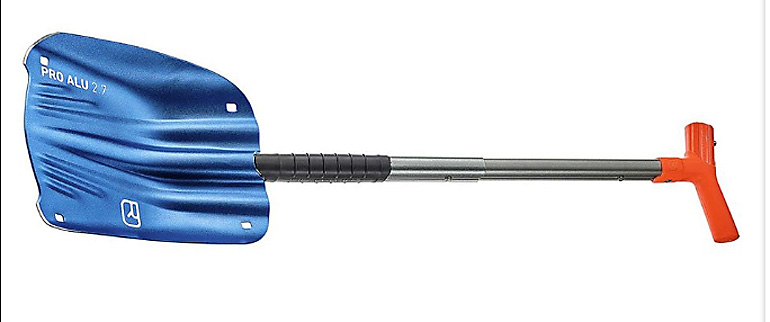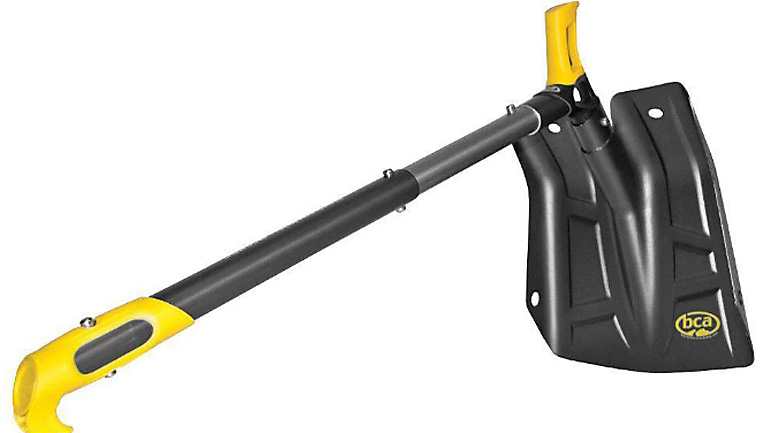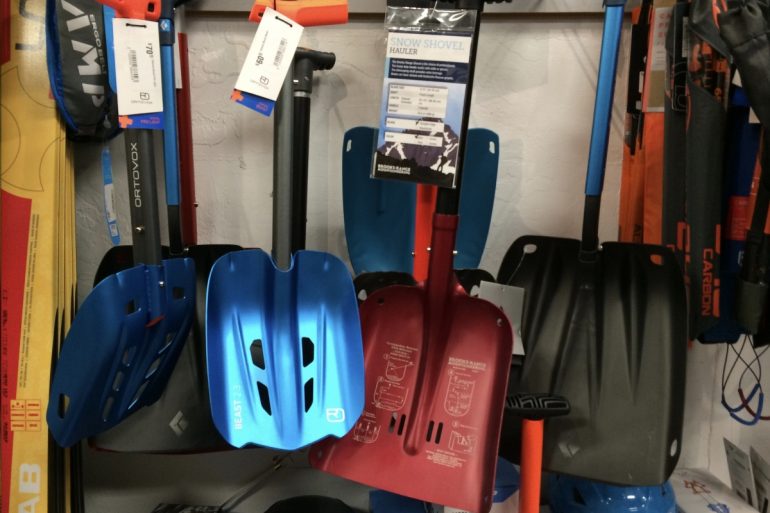Avy shovel recs from folks in the field
What’s the most important thing in your ski touring backpack? I’d argue it’s your extra layer of clothing. But the rescue avy shovel is up there on the list. Which one to carry? The choices seem infinite. Hit an e-tailer and you can probably riffle your eager shopping fingers over more than a hundred versions.
My solution is a corner of my closet, stacked with shovels. In spring, for tours with minimal avy danger, I dig out something like the diminutive CAMP Crest. If I’m studying snow or digging out our cabin, I yank something larger from the pile. Or heading to Denali? There is always our local ranch supply store with a ready stock of grain scoops.
But what if, by preference or necessity, you don’t have a shovel quiver? What’s the ONE? To that end, I polled a variety of long-time ski mountaineers on their “normal shovel choice, mid-winter day of ski touring.” I’ll list a few top picks below (including my own), but first a few points that surfaced and specific things to look for.
1. Blade size should fit in your backpack. This might seem like a no-brainer (doesn’t any commercial avy shovel fit in most backpacks?), but the race-driven trend to smaller/lighter touring gear means smaller rucksacks that a larger shovel might not fit into. As for moving snow, bigger is not necessarily better; those covered here are adequate. Conversely, you can indeed go to small, but the “faves” below do not. These days the popular shovel boast a blade size I’m calling “European minimal.” For example, the Ortovox Pro Alu below specifies at 29 x 22 cm, the BCA Dozer boasts 25.4 x 27.9 cm, and the BCA B1 is 24.9 x 25.4 cm.
2. Extendable handle has become standard, if not mandatory.
3. Hoe or “dozer” feature is desirable (due to current recommendations for efficient rescue digging), but not mandatory.
4. Aluminum, not plastic. (Plastic can work. Downsides: it’s difficult to quality control, and often excessively temperature sensitive. …For today’s show, watch the shovel blow up!)
5. Reputable brand, and model. I’d add that it’s best if your choice has already retailed for a season (for consumer vetting). But I wouldn’t make that mandatory.
6. Reasonable weight. Usually not an issue for purpose built ski touring shovels.
7. Blade has obvious strength, reinforcing ribs, raised sides, etc.
Our avy shovel choices
Shopping links included for those of you doing pre-winter gear upgrades. (Note: this is not intended as a full market survey, it’s more by way of suggestions from myself and others with shovel loads of experience.)
Ortovox Pro Alu
According to a longtime guide and SAR volunteer: “The one and only shovel I carry is a Ortovox Pro Alu 2.7 I like it a lot — it converts to a hoe and also an ice ax (with add-on). The blade is also a good size. I tried another brand’s option, it was too big and did not fit well into my pack.” Weight 794 grams. SHOP FOR IT

The Ortovox Pro Alu.
BCA D2
Two of my contacts voted for the BCA D2. Their take combined: “The BCA D2 is nice and strong, compact, but still fairly light (without the saw). The “ice tool” style hoe grip is effective. The included saw might be considered a gadget, but it’s useful or can be left at home. Obviously strong, and converts to a hoe. I’ve used the same D2 for the last four years or so, and it’s as good as new. Weight 947 grams (with saw). SHOP FOR IT Also note the lighter weight (716 gram) BCA RS EXT as an option, it came recommended as well. It lacks the hook grip but does convert to a hoe.

BCA D2.
Mammut Alugator Pro Light
I’m partial to this shovel. One of the guides I spoke with was as well. It lacks a hoe feature, but everything from the blade size to the shaft length is well thought out. The guide told me it’s been “durable.” Weight 645 grams. SHOP FOR IT

Mammut Alugator Pro Light.
BCA B-1
I’d be remiss to leave this one out of the roundup. In my ever humble opinion, hands down the best combo of quality, design and affordability. No hoe feature. The B-1 blade size exemplifies what I’m starting to call “European minimal” in this case 24.9 cm x 25.4 cm, it thus packs easily, and even the most budget conscious skier can’t balk at fifty bucks for a quality tool. One of the avalanche professionals I polled said it was his favorite, “Cuts a really straight pit wall and fits well in a pack.” I’ve had this shovel in my quiver since it started retail. Weight 600 grams. SHOP FOR IT

The BCA-B1.
Lou’s personal takes
– Some (if not most) shovels have holes in the blade “pocket/bucket” area, for weight savings, lashing, or just to look cool. While less mass is always welcome, a shovel without holes in the bucket part of the blade can function as a snow melting device if you’re benighted and have a fire.
– In my opinion, the fancy serrated or rippled blade edges are nothing more than a marketing device, or proof an over-enthusiastic industrial designer was on the project. In real life, they interfere with using the shovel as a scraper and add nothing to digging efficiency.
– If you do much pit work, you’ll of course want a shovel that suits your methodology, BCA’s tend to be preferred in that vein.
– Again, I’d call the extendable shaft mandatory (though fair exceptions include skimo racing, or touring with virtually zero avy danger).
– Sometimes the blade fits your pack nicely, but the shaft is too long. Remember to check.
– While producing this overview, I noticed fewer options for “larger” shovels. Like those you’d keep outside the door of your cabin, or bring along on an expedition as a “snow mover.” Commentators, if you have any suggestions for this sort of shovel, please share. Also, I’m fully aware I left some of your favorite shovels out of the mix. That’s what the comments are for. I’m looking forward to your take.
WildSnow.com publisher emeritus and founder Lou (Louis Dawson) has a 50+ years career in climbing, backcountry skiing and ski mountaineering. He was the first person in history to ski down all 54 Colorado 14,000-foot peaks, has authored numerous books about about backcountry skiing, and has skied from the summit of Denali in Alaska, North America’s highest mountain.

